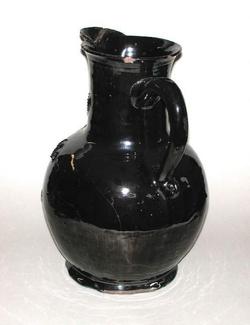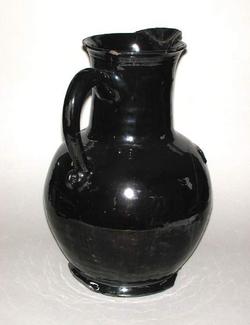Current Location: In storage
Titles
Large Jackfield ware jug
Maker(s)
Production:
Unidentified factory
(Possibly)
Unidentified factory
(Possibly)
Entities
Categories
Description
Dark earthenware jug with applied reliefs and shiny black glaze.
Very large ale jug, bulbous body with wide, tall neck flaring at the mouth, flat foot and loop handle coiled at the lower end. Decorated with applied reliefs including: a (female?) mask under the lip; ‘I W’ on the neck; and ‘Fine Ale’, separated by a cherub, above ’17 90’ on the front. The letters formed from corrugated strips. The whole jug, apart from three pads on the underside, is coated with a thick black (iron manganese) glaze. The underside is flat.
Notes
History note: Bought from Mr (George?) Stoner on 22 July 1907, for £5, by Dr J.W.L. Glaisher, FRS, Trinity College, Cambridge.
Legal notes
Dr J.W.L. Glaisher Bequest, 1928
Measurements and weight
Height: 41.6 cm
Width: 31 cm
Acquisition and important dates
Method of acquisition: Bequeathed
(1928)
by
Glaisher, J. W. L., Dr
Dating
18th Century, Late
Production date:
AD 1790
: inscribed
Note
Jackfield ware was generally made for everyday use – such as tea-pots, kitchen ware, pitchers or drinking mugs – and is often decorated with enamels or gilt. The weight of this jug, however, suggests it was made for display rather than utility.
The lustrous black lead glaze on this jug identifies it as Jackfield ware. Named for Richard Thursfield and his son Maurice who produced such wares at their pottery in Jackfield, Shropshire, c.1713-1772, Jackfield was also produced by other potters in Shropshire and Staffordshire. Thomas Whieldon, of Fenton, Stoke-on-Trent is credited with producing an exceptionally shiny black glaze. Jackfield is also sometimes also known as jet ware, blackware or japanned ware (after Japanese black lacquer ware). It was particularly popular from c.1740-60 and again in the second half of the nineteenth century when Queen Victoria favoured black items in mourning for Prince Albert, who died in 1861.
People, subjects and objects depicted
Components of the work
Decoration
composed of
lead-glaze
( black (manganese iron))
Materials used in production
grey-red
Earthenware
Techniques used in production
Throwing
: Thrown earthenware jug with applied reliefs and shiny black glaze.
References and bibliographic entries
Identification numbers
Accession number: C.1112-1928
Primary reference Number: 71335
Old object number: 2702
Stable URI
Audit data
Created: Saturday 6 August 2011
Updated: Tuesday 30 April 2024
Last processed: Tuesday 15 July 2025
Associated departments & institutions
Owner or interested party:
The Fitzwilliam Museum
Associated department:
Applied Arts







